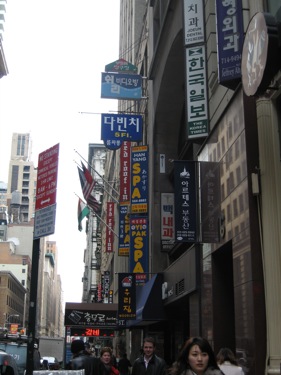Comparison: Little Italy and Koreatown
From Decoding New York
| Introduction |
| Little Italy |
| * Evolution |
| * Here v. There |
| * Economy |
| * What's Real |
| Koreatown |
| * Evolution |
| * Here v. There |
| * Economy |
| * What's Real |
| Comparison |
| * Photo Gallery |
| * Sources
|
Italy and Korea are thousands of miles apart from each other. The people of these countries have completely different traditions, different values, and different appearances. They speak two radically different languages. They share nothing in common except one thing – the experience of the emigrants of those countries in the United States.
Indeed, despite the fact that Italy and Korea may seem to have nothing in common, immigration of Italians and Koreans to the United States builds the bridge between the two. Although the waves of immigration of Italians and Koreans came at different times, there is a parallel line in the push and pull factors of both migrations, and people’s experiences as immigrants starting from their first footsteps in America to the finish line, their success, and everything in between.
First, many Italian and Korean immigrants came to the United States for economic reasons and for greater opportunities to rise up the social ladder. It was hardest for the first immigrants who didn’t have any family members and compatriots in the United States. Those are the ones who struggle the most with the attitude of the new country, the language barrier and new culture. It is evident from the experiences of both groups that family business and social networking play a vital role in social and economic development of immigrants.
There is also a pattern in the approach that both Italian and Korean immigrants took towards assimilation. It is evident that the first immigrant generations were the ones who kept their cultural identity the most; their children, however, were pushed by the parents to learn English and to become “American” as fast as possible. It is clear that immigrants understood that knowing English language and becoming an “American” by partly abandoning your own ethnic identity was in a way one of the ingredients to success. Towards the third and fourth generations of immigrants, the pattern shows that the act of “cutting off the roots” is being reversed; more and more third or fourth generation immigrants try to instill the ethnic and cultural identity and pride in their children by sending them to learn Italian or Korean and educating them about their culture and traditions. People start to understand that not only is it good to know one’s own roots, but it is also a great advantage to know another language and be well rounded in the present highly competitive world.
From the experiences of both Italians and Koreans, one must note that immigration was never an easy feat; it almost in all cases involved great struggles, big adjustments and economic hardships. Interviews of both immigrant groups show that education is a very important aspect of successful life for an immigrant in the United States. Many older immigrants say that one of their biggest regrets about the experience of being an immigrant is that they didn’t go to school and get an education in the United States. They acknowledge the fact that education indeed opens many doors of opportunities. That is why, it is more evident that education is being stressed in the later generations. Overall the second and third generation Italians and Koreans seem to do much better than their parents and grandparents.
One striking difference between Little Italy and Koreatown is its size and current development. Little Italy, being a much older neighborhood, has been noticeably decreasing, as new Chinese immigrants are flooding neighboring Chinatown. Koreatown, on the other hand, is on the peak of its development and growth. This difference, however, may be largely due to the current large influx of Korean immigrants to the US, as opposed to very minimal immigration of Italians. One could predict that maybe like Little Italy, Koreatown will also reach greater heights in its development for several more decades. However, after that, as the number of Korean immigrants decreases, the neighborhood will also start to shrink and will give way to new groups of immigrants. And this way, the cycle of immigration will continue to rotate, justifying the ever-changing rich and diverse neighborhoods of New York City.

